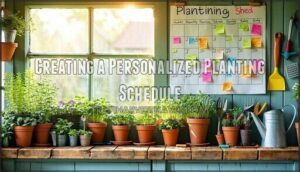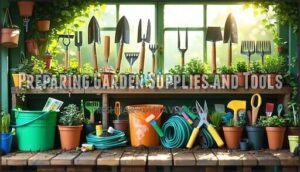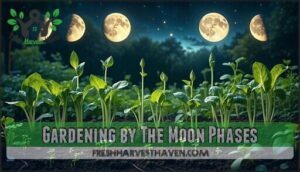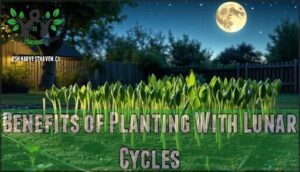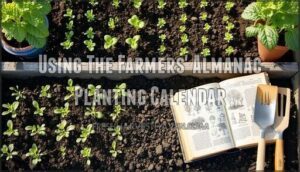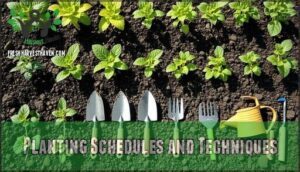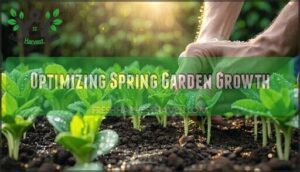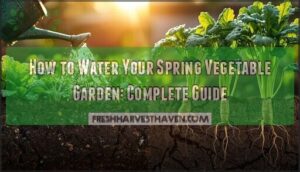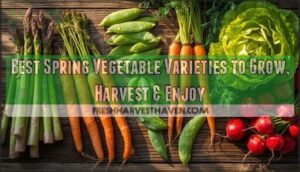This site is supported by our readers. We may earn a commission, at no cost to you, if you purchase through links.
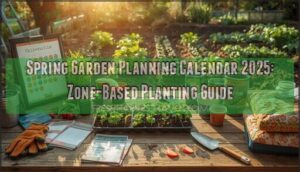
Start by finding your USDA hardiness zone and last frost date, then work backward to schedule indoor seed starting (6-12 weeks before last frost) and outdoor planting dates.
Your calendar should include cool-season crops like lettuce and peas for early spring, warm-season vegetables for after the frost danger passes, and succession planting dates to extend harvests.
Include preparation tasks like soil testing, garden bed prep, and supply ordering.
Factor in your local microclimate and weather patterns for the most accurate timing.
Smart planning prevents both frost damage and missed planting windows, turning gardening guesswork into a precise science that maximizes your harvest potential.
Table Of Contents
- Key Takeaways
- Spring Planting Zones
- Garden Planning Essentials
- Lunar Planting Calendar
- Planting Schedules and Techniques
- Optimizing Spring Garden Growth
- Frequently Asked Questions (FAQs)
- When should I start preparing my garden for spring?
- How do I plan my spring garden?
- What month is a good month to start a garden?
- In what order should I plant my garden?
- When should I start planning my spring garden?
- What are the best veggies to plant in spring?
- How do I prepare my garden for the next spring?
- Why should I create a Spring Gardening calendar?
- What is Spring Garden Planning?
- What is a planting calendar?
- Conclusion
Key Takeaways
- Start your garden planning 10-12 weeks before your last frost date – You’ll need time to order seeds, set up grow lights, and calculate backwards from your target harvest dates to create an accurate planting schedule.
- Know your USDA hardiness zone and local microclimate conditions – Your zip code gives you baseline frost dates, but factors like elevation, urban heat islands, and nearby water can shift your actual planting windows by weeks.
- Plant cool-season crops first, then warm-season varieties after frost danger passes – You can start hardy vegetables like lettuce, spinach, and peas when soil reaches 40-50°F, while tomatoes and peppers wait until all frost risk ends.
- Use succession planting every 2 weeks for continuous harvests – Instead of planting everything at once, you’ll stagger crops like radishes and lettuce to extend your harvest window throughout the growing season.
Spring Planting Zones
Your spring garden’s success depends on knowing your specific planting zone and understanding your local frost patterns.
These factors determine when you can safely plant different crops and which varieties will thrive in your climate conditions.
Finding Your Local Planting Zone
Finding your local planting zone starts with entering your zip code into the USDA zone lookup tool.
This garden planting calendar foundation helps you understand frost dates and microclimate effects that impact your spring garden planning calendar.
Understanding USDA hardiness zones is essential for selecting plants.
Consider these key factors:
- Zone Overlap: Neighboring areas may have different planting dates despite similar climates
- Microclimate Effects: Urban heat islands and elevation changes create hardiness limitations
- Data Sources: Use multiple tools to verify first frost timing for accurate planning
Understanding USDA Hardiness Zones
USDA Hardiness Zones serve as your roadmap for spring garden planning calendar success.
These growing zones map average winter temperatures, helping with Zone Determination and Plant Adaptability decisions.
However, Microclimates Impact can create pockets warmer or cooler than your official hardiness zone.
Climate shifts mean Zone Changes occur over time, affecting Winter Survival rates.
Use gardening zones as starting points, but observe your specific conditions for ideal results.
Determining Last Frost Dates
Beyond consulting historical frost data and frost date averages, you’ll need to take into account microclimate variations in your yard.
Urban heat islands, elevation changes, and nearby water bodies can shift your last spring frost by weeks.
Use online calculators with your zip code for baseline frost dates, but talk to local gardeners for real-world insights.
A useful resource is a tool to calculate frost dates using data from local weather stations.
Local knowledge beats averages when protecting plants and finalizing your planting calendar and planting dates.
Garden Planning Essentials
Successful spring gardening starts with a well-planned schedule that matches your local growing conditions and frost dates.
You’ll need to select plants suited to your specific zone and gather the right supplies before planting season begins.
Creating a Personalized Planting Schedule
Once you know your planting zone, you’ll need a personalized planting schedule that works for your garden’s unique conditions.
Start by mapping your harvest timeline—when do you want fresh tomatoes or crisp lettuce?
Work backwards from these dates to determine when you’ll start seeds indoors or direct sow outdoors.
Consider your microclimate impact carefully.
A south-facing slope warms faster than a shaded valley, shifting your planting dates by weeks.
Use succession planting for crops like radishes and lettuce, sowing new seeds every two weeks for continuous harvests.
Check crop compatibility when planning—some plants grow better together while others compete for nutrients.
Set up planting reminders on your calendar or phone to stay on track throughout the season.
Choosing Suitable Plants for Your Zone
Why settle for plants that struggle in your climate? Smart Regional Plant Selection starts with understanding your USDA Hardiness Zones and Microclimate Considerations.
Your spring garden planning calendar succeeds when you choose Zone-Specific Varieties that thrive locally:
- Native Plant Choices reduce watering needs by 50%
- Cold-hardy vegetables like kale excel in growing zones 3-6
- Heat-loving crops need zones 7+ for maximum yields
- Local Nursery Advice provides climate-tested recommendations
- Planting calendar timing matches your gardening zones perfectly.
Consider purchasing zone-specific plant varieties for best results.
Preparing Garden Supplies and Tools
With your plant choices locked in, it’s time for a thorough tool inventory and garden supplies check.
Sharpen pruners and hoes for effortless cutting. Conduct soil testing to determine pH and nutrient needs.
Set up watering systems like drip irrigation or soaker hoses. Install sturdy plant supports for climbing vegetables.
Stock quality garden gloves for hand protection. Investing in durable gardening gloves can also prevent hand injuries.
Your spring garden planning calendar succeeds when garden tools are prepped and ready!
Lunar Planting Calendar
Many gardeners follow lunar cycles to optimize their planting success, believing that moon phases influence plant growth and germination rates.
You can use established lunar planting calendars like the Farmers’ Almanac to time your spring garden activities with specific moon phases for potentially better results.
Gardening by The Moon Phases
Moon phases offer natural timing cues for your spring planting schedule. Gardening by the moon taps into gravitational forces that affect soil moisture and plant growth patterns.
While Moon Planting Research shows mixed results, many gardeners swear by this Biodynamic Calendar approach for stronger harvests.
- Plant aboveground crops during waxing moon phases when energy flows upward
- Sow belowground crops during waning moon phases for better root development
- Use Ideal Lunar Timing charts to align moon phases with your planting calendar.
Despite Lunar Gardening Myths, Moon Sign Influence remains popular among experienced growers seeking natural gardening rhythms.
Benefits of Planting With Lunar Cycles
Traditional gardeners have worked with moon phases for centuries, recognizing their powerful influence on plant growth.
Lunar Germination occurs more readily during waxing moon periods when gravitational pull draws moisture upward.
Moon Gardening synchronizes your planting calendar with natural rhythms, improving seed sprouting rates by up to 20%.
Gardening by the moon connects your Planting Timing to Cycle Influence patterns.
A Biodynamic Calendar guides when to plant above-ground crops during waxing phases and root vegetables during waning periods.
This lunar planting calendar approach enhances plant vigor and harvest quality.
| Moon Phase | Best For | Timing | Benefits |
|---|---|---|---|
| New Moon | Root crops | Days 1-7 | Strong root development |
| Waxing | Leafy greens | Days 8-14 | Rapid leaf growth |
| Full Moon | Transplanting | Day 15 | Peak moisture absorption |
| Waning | Pruning | Days 16-28 | Reduced plant stress |
Moon Phase Timing transforms ordinary gardens into thriving ecosystems aligned with nature’s blueprint.
Using The Farmers’ Almanac Planting Calendar
The Farmers’ Almanac Planting Calendar combines historical data with regional variations to create your personalized spring garden planning calendar.
This trusted resource considers your specific zip code, integrating lunar cycles with local frost dates for ideal planting schedules. The calendar’s almanac accuracy comes from decades of weather tracking and crop compatibility research.
Here’s how it enhances your gardening success:
- Regional precision – Tailors planting dates to your exact location and last spring frost timing
- Companion planting guidance – Suggests which crops thrive together for maximum garden productivity
- Historical reliability – Uses proven data patterns to predict the best planting windows for your area
Planting Schedules and Techniques
Once you’ve determined your planting zone and last frost date, you can create a practical schedule that maximizes your garden’s potential.
The key to successful spring planting lies in understanding which crops to plant when and using the right techniques for your specific conditions, which is crucial for maximizes your garden’s potential.
Planting Cool-Season Crops in Early Spring
Cool-season crops get your spring garden planning calendar off to a strong start.
Start strong with hardy vegetables that thrive in chilly spring weather.
These hardy vegetables tolerate chilly weather and actually prefer it.
Start with early crop varieties when soil hits 40-50°F.
Use frost protection methods like row covers during unexpected cold snaps.
Succession planting cool-season crops every two weeks guarantees continuous harvests throughout spring.
You can find a variety of cool-season seed options online, which is a great way to get started with spring garden planning and enjoy frost protection methods, and have a strong start with the right seed options.
Sowing Seeds Directly Into Soil
Direct sowing puts seeds exactly where they’ll grow, eliminating transplant shock. Your spring garden planning starts with checking soil temperature—most seeds need 60°F minimum for proper germination. Follow seed depth guidelines by planting seeds 2-3 times their diameter deep. Water gently after sowing to maintain moisture without washing seeds away.
Consider seed starting supplies for ideal growth.
Essential direct sowing steps for your garden planting schedule:
- Test soil temperature daily – use a soil thermometer to track germination rates
- Mark planting rows clearly – prevents accidental weeding of seedlings
- Apply light mulch around seeds – improves weed control while retaining moisture
This direct sowing method works perfectly with your planting calendar timing.
Using Winter Sowing Techniques for Cool-Season Seeds
Winter sowing transforms cool-season seed starting into a hands-off process.
Fill recycled milk jugs or clear containers with potting mix, sow your coolseason crops, and let nature handle seed germination.
The freeze-thaw cycles naturally break seed dormancy while containers create perfect microclimate control.
Your seedlings develop superior frost tolerance through gradual hardening.
Monitor watering needs as snow melts provide moisture.
This container selection method produces stronger transplants ready for spring’s unpredictable weather patterns.
You can improve your yield by understanding cool season requirements.
Optimizing Spring Garden Growth
Once you’ve got your plants in the ground, you’ll need to monitor weather patterns and protect your seedlings from unexpected temperature drops or heavy rains.
Managing common spring pests like aphids and cutworms early will keep your garden healthy and productive throughout the growing season.
Considering Weather and Climate Conditions
With your planting calendar set, weather patterns become your garden’s reality check.
Understanding your local weather data helps you time plantings perfectly and protect vulnerable seedlings.
Smart gardeners track seasonal variations and prepare for extreme weather events that can devastate unprepared gardens.
Microclimate impacts within your yard create unique growing conditions—sunny south-facing slopes warm faster while low-lying areas stay cooler longer.
Weather considerations for spring garden planning include:
- Monitoring frost dates beyond averages using real-time forecasts and soil temperature readings
- Implementing water conservation strategies like mulching and drip irrigation before dry spells hit
- Adapting to climate change by selecting heat-tolerant varieties and adjusting traditional planting windows.
Your garden zone provides the foundation, but local weather conditions determine daily success.
Managing Pests and Diseases in Spring Gardens
Through pest identification and regular scouting, you’ll catch problems before they damage your spring garden.
Check leaf undersides and stems where pests hide. Introduce beneficial insects like ladybugs for natural pest control against aphids.
For disease prevention, space plants properly to improve air circulation and reduce fungal diseases.
Use organic controls and crop rotation to break pest cycles. Healthy soil health supports stronger plants that resist both pests and diseases naturally through effective disease management strategies.
Maintaining a Healthy and Productive Spring Garden
Successfully managing pests and diseases sets you up for ongoing spring garden maintenance success.
Your garden productivity depends on consistent care throughout the growing season.
Here’s your spring garden checklist for maintaining healthy garden health:
- Monitor daily for pest activity, watering needs, and emerging weeds that compete with your plants
- Apply deep watering strategies infrequently to encourage strong root development and drought resistance
- Practice proactive weed control through mulching benefits and removing invaders before they reproduce
Regular soil health assessments and companion planting decisions support your spring garden planning efforts.
Remember to amend soil properly with compost or manure.
This garden planning calendar approach guarantees your spring garden maintenance routine delivers maximum results from your initial planting investments.
Frequently Asked Questions (FAQs)
When should I start preparing my garden for spring?
Start browsing seed catalogs, order supplies, and set up grow lights twelve weeks before your last frost date.
Begin indoor seed starting for leeks and onions ten weeks prior, then start other crops progressively based on their specific timing requirements.
How do I plan my spring garden?
Determine your last frost date, then calculate planting times by working backward.
Choose varieties suited to your zone, sketch your garden layout, and create a rotation plan.
Start seeds indoors based on timing requirements.
What month is a good month to start a garden?
March through May are ideal months to start your garden.
You’ll plant cool-season crops like lettuce and spinach in March, while warm-season vegetables like tomatoes get started indoors for later transplanting.
In what order should I plant my garden?
Like knights charging into battle, you’ll plant cool-season crops first—lettuce, spinach, peas—then warm-season vegetables like tomatoes and peppers after frost danger passes completely.
When should I start planning my spring garden?
You’ll want to begin planning your garden 10-12 weeks before your last spring frost date.
This timing allows you to order seeds early, set up indoor growing equipment, and create your garden layout while there’s still time to make adjustments, which enables you to have a garden layout.
What are the best veggies to plant in spring?
Cool-season crops thrive in spring’s mild temperatures.
Plant lettuce, spinach, peas, carrots, radishes, and broccoli early since they tolerate light frost.
These vegetables prefer cooler weather and will bolt in summer heat.
How do I prepare my garden for the next spring?
Start soil testing and amending 8-12 weeks before your last frost date.
Order seeds early, set up grow lights, and sketch your garden layout.
Prepare beds, gather tools, and plan crop rotation for ideal spring success.
Why should I create a Spring Gardening calendar?
Creating a spring gardening calendar helps you time plantings perfectly, maximize harvests through succession planting, and avoid costly mistakes like frost damage or bolting crops.
You’ll stay organized and boost your garden’s productivity.
What is Spring Garden Planning?
Spring garden planning involves organizing your planting timeline around your last frost date.
You’ll schedule when to start seeds indoors, prepare beds, and transplant seedlings outdoors for ideal growth and harvest timing, which is a complete concept in itself.
What is a planting calendar?
Eighty percent of gardeners who use planting calendars report better harvests than those who don’t.
You’ll get a customized schedule showing exactly when to start seeds indoors and transplant outdoors based on your local frost dates and growing zone.
Conclusion
Success mirrors a well-tended garden—both require careful planning and timely action.
Your spring garden planning calendar transforms scattered intentions into organized growth.
By knowing your zone, tracking frost dates, and scheduling plantings, you’ll create a thriving ecosystem rather than hoping for luck.
Remember to adjust your calendar based on local conditions and weather patterns.
With proper timing and preparation, your garden becomes a reliable source of fresh produce throughout the growing season.

